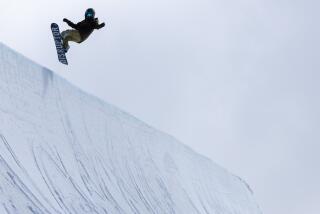HOLIDAYS : Playing It Safe : Children can be injured on poorly designed playgrounds. Here’s what to watch for when making a purchase.
As parents go searching for exciting back-yard play equipment to satisfy their children’s holiday wish lists, there is more to consider than appearance and price tag. Some play systems may not be safe.
When Debbie Kellerman’s son was 7, he was cut on bolts sticking out of an old metal swing set that had been in their back yard for years. Kellerman was surprised that such a simple piece of equipment could cause an injury.
But her experience was not unusual. More than 500 children a day are treated in emergency rooms around the country for injuries from using playground equipment, according to the American Academy of Pediatrics (AAP). And every year, between 10 and 20 youngsters die from playground injuries.
The majority of the injuries--about 75%--are caused by falling off or tripping over play equipment. Other problems are typically triggered by the equipment--most often, swings hitting the child, or from sharp edges, hardware or loose nails or screws, according to AAP data.
After her son’s injury, Kellerman got interested in learning more about what makes play equipment safe, and she started searching local showrooms and play structure conventions to see what the market offered.
Seven years ago, after she realized there was a market for safe systems, she added play area design and sales to her Northridge company, Sennergetics, which also sells wholesale solar heating units for pools and spas. Today she sells pre-assembled play systems, and designs custom play areas for schools and residences, using basic equipment from a variety of manufacturers.
“More than 70% of all playground injuries occur when a child falls from equipment to an unyielding surface,” said Kellerman, who encourages parents and teachers to inspect a play area before they let children loose. According to the AAP, a 1-foot fall onto asphalt or concrete, or a 4-foot fall onto packed earth or grass can cause a fatal head injury.
“Look for sand that has been pushed away from the end of a slide, bare spots near swings, exposed concrete that is no longer covered by bark, because these are common causes of children’s injuries,” she said. Parents also should look for broken glass, test the metal slides to see if they are too hot to be safely used and check the swings and other equipment for loose bolts and fittings, unsanded wood or unsafe chains, she said.
The AAP advises parents to make sure swings are made of soft material, such as rubber, plastic or canvas, and to check to ensure the children cannot reach any moving parts that might pinch or trap any part of the body. Parents also should provide play equipment that is the right size for the child; smaller swings can break if used by heavier kids.
Children love to pretend they’re in treehouse-like forts, she said, but parents should make sure that any platform is totally enclosed by a bar if it stands higher than 5 feet off the ground. Protective bars need to be attached low enough so that smaller children can’t fall off, Kellerman added.
She doesn’t like playhouses that are totally enclosed--”kids shouldn’t be out of sight”--and has found trap doors, which are sometimes beloved features of elevated play houses, to be unsafe.
The design of a play area is crucial to safety because attention has to be paid to the natural traffic patterns of children using the equipment, Kellerman said. The slide needs to be set away from the swings, for example, because children typically turn back immediately to reclimb the slide’s ladder after coming down. If the swings are in the way of that pattern, accidents will be more likely.
The AAP also recommends that play equipment be installed at least 6 feet from any wall or fence, and that it be well anchored to prevent tipping.
Concrete anchors should be covered, cushioned or sunk under the ground to prevent injury, the organization recommends.
Any space in the equipment needs to be big enough so a child’s head can’t get caught, but not so wide that a child can fall through the space, she advised.
And no matter what the equipment is like, Kellerman said it has to be well-maintained.
What is most important is that children be well-watched, she said. “The key--above all--is to be sure children are supervised when they’re playing. Accidents will happen, and good design will minimize the potential, but nothing substitutes for supervision.”
WHERE TO GO
Information: For a free copy of the American Academy of Pediatrics brochure on play equipment, send a self-addressed, stamped envelope to: “Playground Safety: Guidelines for Parents,” Department C, American Academy of Pediatrics, P.O. Box 927, Elk Grove Village, Ill. 60009-0927.
More to Read
Inside the business of entertainment
The Wide Shot brings you news, analysis and insights on everything from streaming wars to production — and what it all means for the future.
You may occasionally receive promotional content from the Los Angeles Times.










